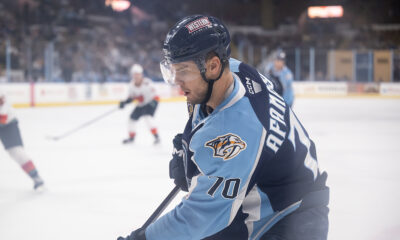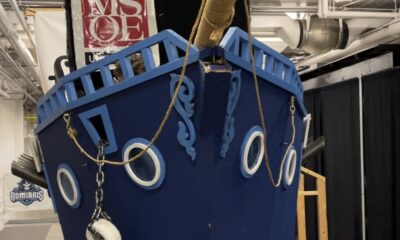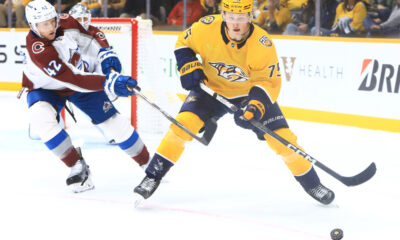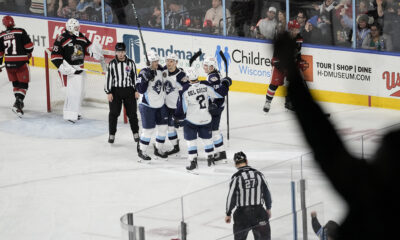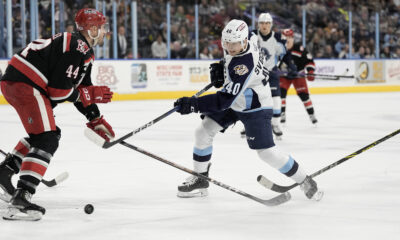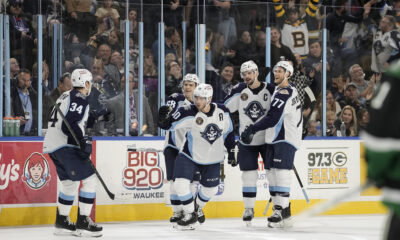Previously, we looked at the state of the Nashville Predators roster we addressed the idea that the organizational culture has kept forwards acquired from elsewhere from performing at or above their career standards. Now, we look at how the good and the bad of how the roster was constructed and how it could evolve to be better both in ‘20-21 as well as set up for long term success.
Lineup Construction
Let’s start with one baseline. The Predators are not a bad hockey team. In fact, looking at the analytics from the Coyotes series they can be a very good team especially at the top of the roster. The reunited JoFA line and the top defensive pair of Josi and Ellis were simply dominant.
Looking at these two groups from a lineup construction perspective it is easy to see the fit. In JoFA, the Predators have a center with size and elite passing skill, a do-everything winger with elite stick skills, and a high speed winger who forechecks like crazy and joyously rips 1980’s clappers past helpless goalies.
In the Josi-Ellis pairing there is an elite puck handler who can score from anywhere and a do-everything defenseman who is an excellent passer with a monster shot. A special shout out also goes to the Bonino line that was well matched and punched way above its weight but a third line can’t be what carries the team offensively.
In all these cases the players complement and enhance each other’s skill sets. With exception of truly elite talents who can enhance anyone playing with them, the goal when constructing a lineup should be to create scenarios where the players can use their strongest abilities without exposing their weaknesses.
A consistent negative throughout the season was that the top 6 forward spots were being constantly scrambled due to lack of production, baffling coaching decisions and injuries. While it is easy to just blame ex-coach Peter Laviolette’s line blender for the subpar results, there must also be a recognition that the collection of forwards simply didn’t work as a group. To bring the talent forth and optimize the play across the lineup, the roster needs an overhaul to remove redundant pieces and elevate younger talent.
Defensively, Dante Fabbro contributed little offensively in his first full season but was fine in his own end. The expected rookie mistakes unfortunately meant Mattias Ekholm spent more energy covering for the both of them and it showed in his overall contributions. Additionally, the Predators 3rd defensive pair was consistently made up of players who were at best replacement level but more often were a disaster. The 3rd pair was time and again pinned in their own zone for long periods.
Assessing the Roster
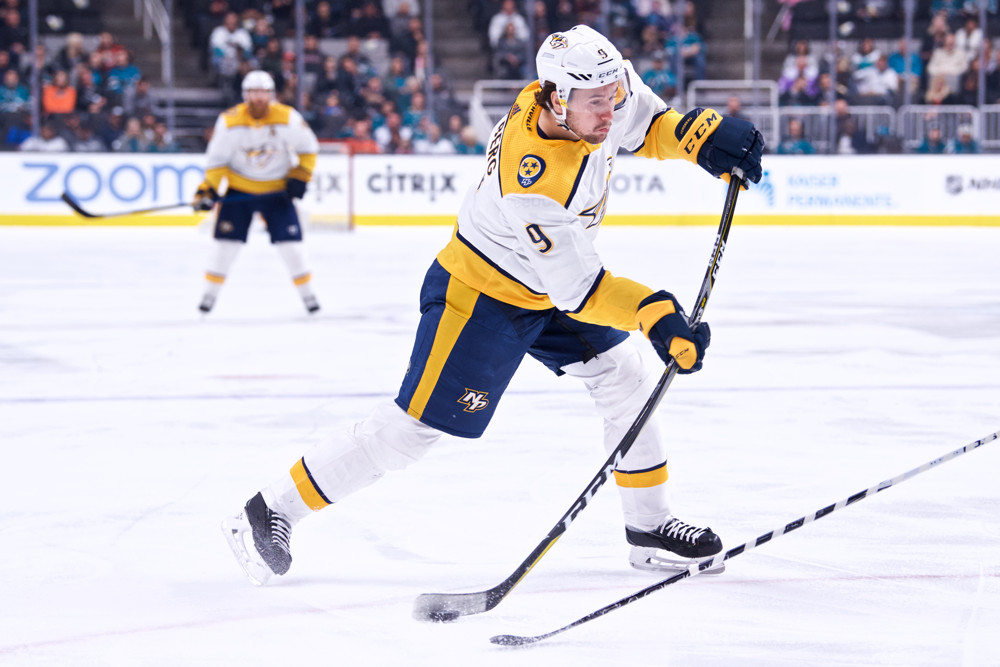
Starting with the forwards, the crossroads for the Predators roster is highlighted by the state of the team’s contracts and salary cap. While a number of players are locked up longer term, there are a number of roster decisions to be made around both current and prospective forwards. Looking at the existing set of forwards a set of categories emerge:
- Core: Filip Forsberg, Viktor Arvidsson, Matt Duchene
- Locked Up: Ryan Johansen, Kyle Turris, Colton Sissons, Rocco Grimaldi
- Supporting Cast: Nick Bonino, Calle Jarnkrok, Austin Watson
- UFA: Mikael Granlund, Craig Smith, Colin Blackwell
- Rising AHL Prospects: Yakov Trenin, Eeli Tolvanen, Rem Pitlick
- Wild Card: Philip Tomasino
There is a whole lot of salary and term tied up in those first two categories but also a lot of capability and history of production. More than likely they are all on the roster next season. The major question mark is Kyle Turris. Turris has looked better under John Hynes but remains largely untradeable at this time and Poile is unlikely to eat an 8 year buyout. Also, Turris is still a talented player so it would make more sense to try and properly utilize him than take a significant hit either in buyout cap or additional trade assets trying to remove him and have to replace him in the lineup.
The supporting cast, however, is more up in the air as they are all getting older. At this point, it may make sense for the Predators to part ways with them all and take the opportunity to get younger and cheaper. Bonino has undoubtedly proven his value to the Predators, but he’s also entering the final year of his deal. As a veteran center at a reasonable cost coming off a really strong season his trade value is probably as high as it can be.
Similarly, Calle Jarnkrok is a useful player who has filled a number of roles for the Predators but his ceiling is limited as a 4th liner. His lineup flexibility and great contract (2 more years at $2M AAV) will have value to other teams. Austin Watson is the most difficult case. The decision to give him a 3 year extension was honestly a questionable one. I understand showing loyalty to players, but objectively he contributes very little on the ice and ended up seeing the press box quite often down the stretch of the regular season. His stronger performance in the qualifying round plus cheap cap hit could possibly make him a tradable asset but he more likely would be bought out or waived to Milwaukee as a depth forward.
The decisions on the UFA group will be driven largely by player asks in terms of contracts but in the cases of Smith and Granlund the Predators must be careful. Smith has been one of the most consistent year to year performers and brings but is now in his 30’s. Bringing him back would tie up cap space that may be needed elsewhere. Granlund showed signs of life under Coach Hynes and does bring a lot of skill to the lineup but overall the trade that sent Kevin Fiala to the Wild has been underwhelming. While still in his 20’s, if a shorter term “prove-it” deal could be struck then then he could be a solid player to keep around. Anything long term, however, would be a huge risk.
The final member of the UFA group, Colin Blackwell, made significant strides as a bottom 6 contributor who can play center or wing, has some scoring touch and brings the physical play. He should be re-signed and given a chance at a regular lineup spot.
The rising AHL prospects have all shown flashes of ability that could be ready for NHL action. Yakov Trenin got his first run with the Predators and showed his size, strength and puck control. He continues to be an excellent forechecker and beast in front of the net. Tolvanen got off to a slow start in Milwaukee but over the final 3rd of the regular season he kicked into gear and was a scoring machine. If that close to the season was his turning point then he could be ready to contribute as well. Rem Pitlick was one of the final cuts in training camp and showed why with a solid first professional campaign. He showed his speed, skill and full ice play all season long.

The wild card to all of this is 2019 first round pick Philip Tomasino. Simply put, Tomasino dominated across two teams in the OHL. He cracked the 100 point plateau and was a dynamic presence every night out. When the NHL returned to the abridged training camps Tomasino was invited as a participant but was not ever slotted with the main group. He has stated his goal to make the Predators 20-21 roster out of training camp. If he is deemed ready then his presence would almost certainly be a top 6/top 9 role out of the gate. However it is still very possible he spends one more year in the OHL refining his game.
On the defensive side, the top 4 are fully locked in. Josi, Ellis and Ekholm continue to be some of the best in the entire NHL and while Fabbro had his struggles, he is a talented player who will improve in year two. Korbinian Holzer (remember the Preds also gave up a draft pick to get him?) and Yannick Weber should all be let walk as UFA’s. Dan Hamhuis recently announced his retirement, so that roster spot is now open. Jarred Tinordi has one year left but is a fringe NHL-er at best. The Predators do have a number of defensemen in Milwaukee (Carrier, Allard, Davies) who are knocking on the door and the opportunity may finally be there for them to attain regular NHL status.
A View on 2020-21
There is a fair bit of roster turnover above so let’s start by recapping all the changes. First, some highlights are that Granlund is retained for two years at $6M and that Philip Tomasino wins a spot on the opening day roster. On the defensive side, free agent Dylan DeMelo was signed away from Winnipeg on a one year, $2M deal. Putting this all together using CapFriendly’s excellent Roster Simulator tool, the Nashville Predators would enter the 2020-2021 season with $79.26M committed against the salary cap leaving just over $2M in cap space. Now, let’s look at who could make up the ‘20-21 roster.
First, the forwards staying put/graduating from Milwaukee:
- Centers: Ryan Johansen, Matt Duchene, Kyle Turris, Colton Sissons, Philip Tomasino
- Left Wings: Filip Forsberg, Eeli Tolvanen, Rocco Grimaldi, Colin Blackwell
- Right Wings: Viktor Arvidsson, Mikael Granlund, Yakov Trenin, Rem Pitlick, Michael McCarron
Now for the defensemen staying put/graduating/signed:
- Roman Josi, Ryan Ellis, Mattias Ekholm, Dante Fabbro, Jarred Tinordi, Alex Carrier, Dylan DeMelo
And now finally the players who would be leaving the Predators roster:
- Craig Smith (UFA), Nick Bonino (Trade), Calle Jarnkrok (Trade), Austin Watson (Waived/AHL), Yannick Weber (UFA), Korbinian Holzer (UFA), Dan Hamhuis (UFA)
With all of these changes the Predators roster successfully gets younger, inserts players with higher ceilings and creates a better lineup construction to take advantage of the various skill sets.
Nashville Predators 2020-2021 Lineup
L1: Forsberg-Johansen-Arvidsson
L2: Tolvanen-Duchene-Granlund
L3: Grimaldi-Turris-Tomasino
L4: Blackwell-Sissons-Trenin
Extras: Pitlick, McCarron
P1: Josi-Ellis
P2: Ekholm-Fabbro
P3: DeMelo-Carrier
Extra: Tinordi
While this lineup gives up a lot in terms of experience to the prior iteration, the added firepower in Tolvanen and Tomasino is undeniable. Each line is built to have a balance of speed, scoring ability, playmaking and forechecking. JoFA returns full time to carry the momentum they saw during the qualifiers. Tolvanen added to the second line should help create space for Duchene/Granlund to operate because his shot must be accounted for. Grimaldi’s and Tomasino’s speed should open up the ice for Turris to get more chances. The fourth line with Trenin and Blackwell maintains the physical presence while also having the capability to be dangerous offensively.
On the blue line, the top 4 returns intact as one of the best in the league. A more experienced and improved Fabbro should help both his and Ekholm’s production. On the third pair, adding DeMelo and inserting Carrier full time gives more speed and capability moving the puck out of the zone. I gave Carrier the edge over Davies and Allard due to his previous NHL chances and status as an AHL all-star last season but all three of them could get an extended look with the big club.
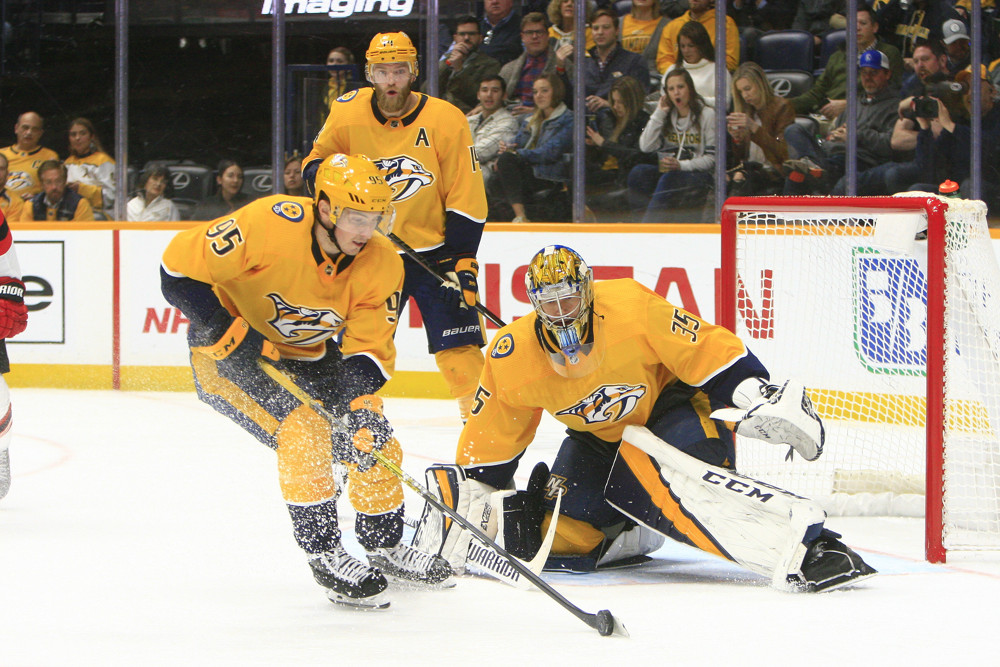
While there are a lot of changes to the roster, the most talented players are kept and put in positions to succeed. The biggest challenge is that GM David Poile must be willing to let go of the loyalty to hard working veterans and pull the trigger on bringing the young talent into the fold. If this can be done, then the roster overhaul can be fulfilled to set the team up for success both short and long term.
- Statistics courtesy of NHL.com
- Contract and salary cap information courtesy of CapFriendly.com
- Visualizations courtesy of Sean Tierney (@chartinghockey) and Micah Blake McCurdy (@ineffectivemath


